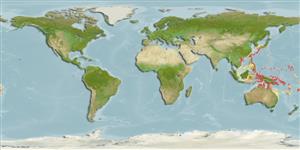Environment: milieu / climate zone / depth range / distribution range
Ecología
marino asociado a arrecife; rango de profundidad 10 - 25 m (Ref. 90102). Subtropical
Western Pacific: Japan, Guam, New Guinea, and the Great Barrier Reef.
Tamaño / Peso / Age
Maturity: Lm ? range ? - ? cm
Max length : 7.5 cm SL macho / no sexado; (Ref. 48637)
Short description
Morfología | Morfometría
Espinas dorsales (total): 6 - 7; Radios blandos dorsales (total): 12; Espinas anales 1; Radios blandos anales: 12. Characterized by pale grey to whitish body color; several large brown spots on middle of side; back and side interspersed with brown mottling; posterior margin of first dorsal fin with pair of pale-edged black spots; united pelvic fins, well developed frenum present; longitudinal scale series 54-58; posterior body with ctenoid scales, becoming cycloid anteriorly; head without scales; greatest depth of body 5.5-6.4 in SL; lanceolate caudal fin, a little longer than head length; reduced posterior oculoscapular sensory canal, single pore (H') present (Ref. 90102).
Inhabits fine carbonate sand bottoms of well-protected lagoons (Ref. 37816). Found in coastal bays and estuaries on sand or muddy substrates to 25 meters depth (Ref. 48637). Also found in lagoons and sheltered bays in 10-25 m (Ref 90102).
Life cycle and mating behavior
Madurez | Reproducción | Puesta | Huevos | Fecundidad | Larva
Masuda, H., K. Amaoka, C. Araga, T. Uyeno and T. Yoshino, 1984. The fishes of the Japanese Archipelago. Vol. 1. Tokai University Press, Tokyo, Japan. 437 p. (text). (Ref. 559)
IUCN Red List Status (Ref. 130435)
Threat to humans
Harmless
Human uses
Más información
Nombres comunesSinónimosMetabolismoDespredadoresEcotoxicologíaReproducciónMadurezPuestaAgregación para la puestaFecundidadHuevosEgg development
Age/SizeCrecimientoLength-weightLength-lengthLength-frequenciesMorfometríaMorfologíaLarvaDinámica larvariaReclutamientoAbundanciaBRUVS
ReferenciasAcuiculturaPerfil de acuiculturaRazasGenéticaElectrophoresesheritabilidadEnfermedadesProcesamientoNutrientsMass conversion
ColaboradoresImágenesStamps, Coins Misc.SonidosCiguateraVelocidadTipo de nataciónSuperficie branquialOtolitosCerebrosVisión
Herramientas
Special reports
Download XML
Fuentes de Internet
Estimates based on models
Preferred temperature (Ref.
123201): 25.2 - 29.3, mean 28.6 °C (based on 1198 cells).
Phylogenetic diversity index (Ref.
82804): PD
50 = 0.5000 [Uniqueness, from 0.5 = low to 2.0 = high].
Bayesian length-weight: a=0.00708 (0.00333 - 0.01504), b=3.09 (2.92 - 3.26), in cm total length, based on LWR estimates for this (Sub)family-body shape (Ref.
93245).
Nivel trófico (Ref.
69278): 3.3 ±0.4 se; based on size and trophs of closest relatives
Resiliencia (Ref.
120179): Alto, población duplicada en un tiempo mínimo inferior a 15 meses (Preliminary K or Fecundity.).
Fishing Vulnerability (Ref.
59153): Low vulnerability (10 of 100).
